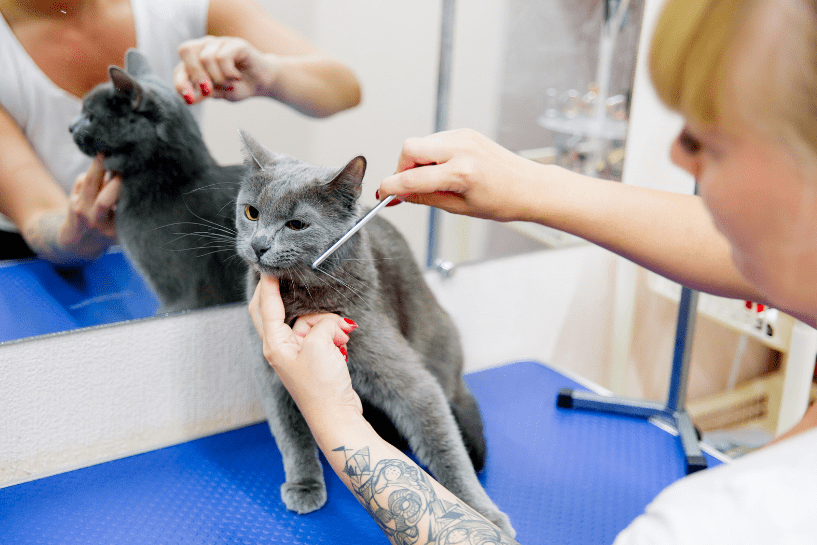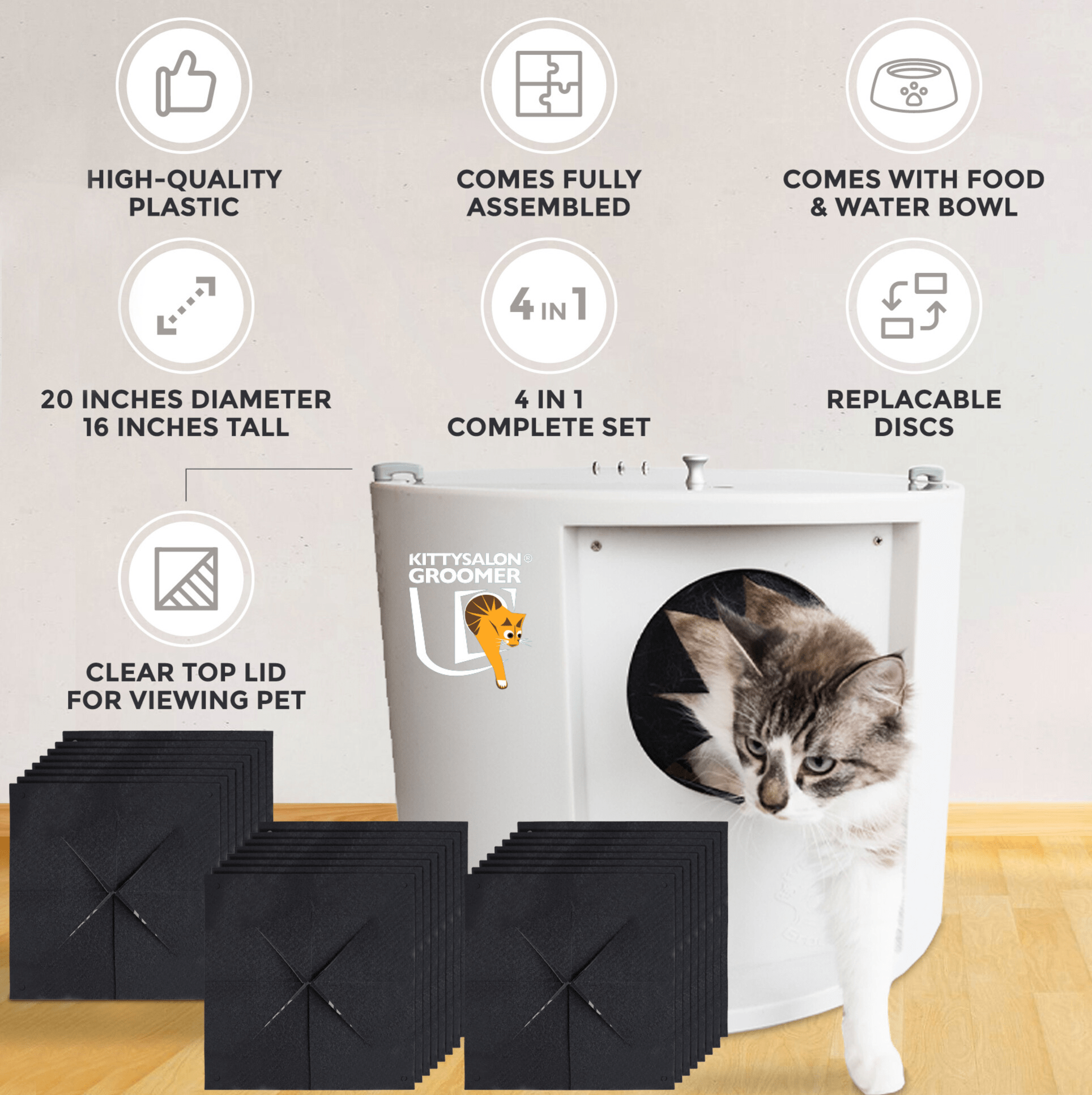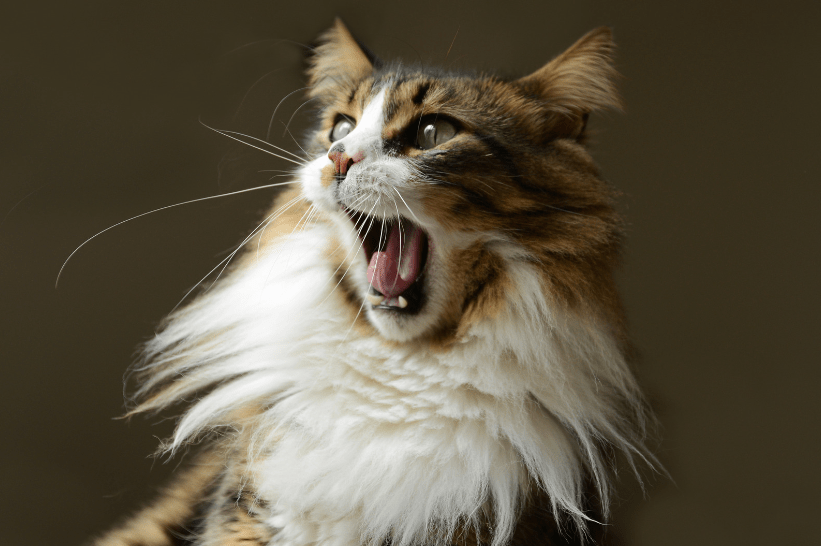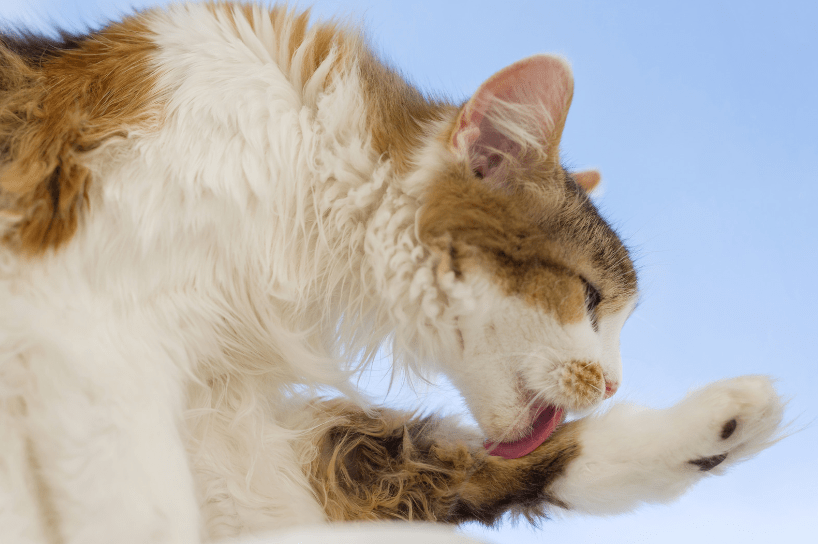To reduce cat hair in the home, regularly brush your cats using a FURminator comb to minimize shedding and promote their overall health. Additionally, use a robot vacuum daily to effectively remove hair from the floor.
Grooming your cat regularly will not only reduce shedding but also improve the appearance of their coat by distributing natural oils. Making brushing a routine and offering rewards or extra attention can help make it an enjoyable experience for your cat.
Another option is to groom, bathe, or shave your cat, although shaving won’t completely prevent shedding. Consider investing in a vacuum specifically designed for cat hair and use tools like a pet hair sponge, rubber gloves, bristle brush, or a dusting mop on hard surfaces to further tackle cat hair in your home.
Understanding Cat Hair
Reduce cat hair in your home by regularly brushing your cat and using a FURminator comb, which will help remove loose fur and improve their overall health. Additionally, invest in a robot vacuum to help keep your floors clean and minimize the amount of hair on the floor.
Why Cats Shed?
Cats shed their hair as a natural process that helps them maintain a healthy coat. Shedding allows cats to get rid of old and damaged hair, making way for new hair to grow. It also helps regulate their body temperature and remove dirt or debris that may have accumulated in their fur.
How Much Do Cats Shed?
The amount of shedding varies greatly among different cat breeds. Some cats, such as the Persian or Maine Coon, have long and thick hair that sheds more compared to short-haired breeds like the Siamese or Abyssinian. Additionally, factors like the season, age, and overall health of the cat can also affect the amount of shedding.
Where Does Cat Hair Go?
Cat hair can end up in various places within your home. It can accumulate on furniture, carpets, bedding, and even clothing. Additionally, cat hair tends to float in the air and can settle on surfaces, creating a layer of furry residue. It is important to regularly clean and vacuum these areas to minimize the presence of cat hair and maintain a clean environment.
The Impact Of Cat Hair On Allergies
For individuals with allergies, cat hair can be a major trigger. The proteins found in cat saliva, urine, and dander can cause allergic reactions ranging from mild symptoms like sneezing and watery eyes to more severe reactions such as difficulty breathing. Keeping cat hair under control and maintaining proper hygiene can help reduce allergic reactions and create a more comfortable environment for both cats and their human companions.

Regular Grooming
Regular grooming is essential for maintaining a clean and hair-free environment in your home. Taking the time to groom your cat not only ensures their overall well-being but also helps to reduce the amount of cat hair that ends up on your furniture, clothes, and floors. In this section, we will discuss why grooming is important, the best grooming tools for cats, and how to groom your cat properly.
Why Grooming Is Important?
Grooming is not only about keeping your cat looking their best but also plays a crucial role in their overall health. 🐱 Regular grooming helps to:
- Remove loose fur and reduce shedding
- Prevent matting and tangles in their coat
- Stimulate blood circulation and promote healthy skin
- Prevent hairballs from forming in their digestive system
Best Grooming Tools For Cats
When it comes to grooming your cat, having the right tools can make the process easier and more effective. Here are some of the best grooming tools to have:
- A soft bristle brush or a slicker brush to remove loose fur and tangles
- A metal comb with wide and narrow teeth for detangling and removing debris
- A grooming glove or mitt for gentle massaging and removing loose fur
- Nail clippers or a scratching post for keeping their claws trimmed
- Ear cleaning solution and cotton balls for maintaining clean ears
How To Groom Your Cat
Grooming your cat at home can be a bonding experience for both of you. Follow these steps to ensure a successful grooming session:
- Find a quiet and comfortable area where your cat feels relaxed.
- Start by gently brushing their fur to remove any loose hair.
- Use a comb to detangle any knots or mats, starting from the base of the fur and working your way up.
- Check their ears and gently clean them if necessary, using a damp cotton ball and ear cleaning solution.
- Trim their nails regularly using cat-specific nail clippers or a scratching post.
- End the grooming session with a treat or praise to reward your cat for their cooperation.
Grooming your cat regularly not only helps to minimize the amount of cat hair in your home but also contributes to their overall health and well-being. Remember to make grooming a positive and enjoyable experience for your feline friend.
Creating A Cat-friendly Living Space
Are you tired of cat hair taking over your home? Creating a cat-friendly living space is essential in reducing cat hair in your home. By making a few changes and implementing some simple strategies, you can create a harmonious environment for both you and your feline friend. In this blog post, we will explore different ways to reduce cat hair in your home, starting with creating a cat-friendly living space.
Choosing Cat-friendly Furniture
When it comes to selecting furniture for your home, it’s important to choose cat-friendly options. Opt for materials that are easy to clean, such as leather or microfiber, as they don’t attract cat hair as much as other fabrics. Avoid furniture with deep crevices or intricate designs that can trap cat hair and make it difficult to clean. Additionally, consider furniture with removable and washable covers, making it easier to remove cat hair when necessary.
Tips For Reducing Cat Hair On Furniture
- Regularly groom your cat to minimize shedding.
- Place a blanket or a washable throw on furniture to catch cat hair.
- Use a lint roller or a rubber glove to remove cat hair from furniture surfaces.
- Vacuum furniture regularly using a vacuum cleaner with a pet hair attachment.
Creating Designated Cat Zones
Creating designated cat zones in your home can help contain cat hair to specific areas. Provide your cat with their own space, such as a cozy cat bed or a scratching post, where they can relax and play. By giving them their own designated areas, you can avoid cat hair spreading throughout the entire house.
Covering Surfaces To Reduce Cat Hair
One effective way to reduce cat hair on surfaces is by covering them. Use washable throws or blankets to cover your furniture, especially in areas that your cat frequently relaxes on. This will not only protect your furniture from cat hair but also make it easier to clean when needed. Additionally, consider using adhesive furniture covers on surfaces like tables or countertops, as they can easily trap and remove cat hair.
By implementing these strategies and creating a cat-friendly living space, you can significantly reduce cat hair in your home. Remember to regularly groom your cat, choose cat-friendly furniture, create designated cat zones, and cover surfaces to minimize cat hair accumulation. With a bit of effort and care, you can create a cleaner and more hair-free environment for both you and your beloved feline companion.

Maintaining A Clean Home
Cat hair can easily get everywhere in your home, from furniture to clothing and bedding. Maintaining a clean home is essential to reduce the amount of cat hair and ensure a hygienic living environment. By following these simple tips, you can effectively minimize cat hair in your home.
Vacuuming Tips For Removing Cat Hair
The vacuum cleaner is your best friend when it comes to removing cat hair from carpets, rugs, and upholstery. Here are some vacuuming tips to effectively tackle cat hair:
- Vacuum your floors and furniture at least twice a week to stay ahead of the cat hair buildup.
- Invest in a vacuum cleaner specifically designed for pet hair, as these come with powerful suction and specialized attachments.
- Use a rubber brush attachment or a rubber broom to lift cat hair from carpets and upholstery before vacuuming.
- Clean or change your vacuum filters regularly to maintain optimum suction for cat hair removal.
Using Lint Rollers And Sticky Brushes
Lint rollers and sticky brushes are handy tools for removing cat hair from clothing and upholstery. Follow these tips to use them effectively:
- Keep lint rollers or sticky brushes in multiple locations around your home, such as in your bedroom, living room, and coat closet.
- Roll the lint roller or brush in short, quick strokes over the affected area to pick up cat hair.
- Replace the sticky sheets on the lint roller regularly for optimal performance.
- To remove cat hair from upholstery, dampen a rubber glove and rub it over the surface – the hair will stick to the glove.
Cleaning Cat Hair From Hard Surfaces
Cat hair can also accumulate on hard surfaces like countertops, floors, and tables. Follow these tips to effectively clean cat hair from hard surfaces:
- Use a microfiber cloth or a damp sponge to wipe cat hair off hard surfaces.
- Alternatively, use a lint-free cloth sprayed lightly with water or a diluted fabric softener solution to attract and remove cat hair.
- In corners and crevices, use a small brush or an old toothbrush to dislodge and collect cat hair.
Minimizing Cat Hair On Clothing And Bedding
Having cat hair on your clothing and bedding is not only unsightly but can also cause allergies. Here’s how you can minimize cat hair on clothing and bedding:
- Designate cat-free zones in your home, such as your bedroom, to reduce the amount of cat hair on your clothing and bedding.
- Use a lint roller or a sticky brush before leaving your home to remove any cat hair that may have transferred onto your clothing.
- Consider using washable throws on your furniture and bed, which can be easily cleaned to remove cat hair.
- Wash your clothing and bedding regularly in hot water and use a pet hair remover detergent or add a cup of white vinegar to the washing machine to attract and remove cat hair.
By regularly following these maintenance tips, you can significantly reduce cat hair in your home and create a cleaner, healthier living environment for both you and your feline companion.
Controlling Cat Hair In Specific Areas
Learn effective techniques to control and reduce cat hair in specific areas of your home. Regular brushing, using a FURminator comb, and investing in a robot vacuum can significantly decrease the amount of cat hair on floors and furniture.
Managing Cat Hair On Carpets And Rugs
If you have carpets or rugs in your home, you know how cat hair seems to cling to them with a vengeance. However, there are some simple steps you can take to manage cat hair in these specific areas.
1.
Vacuum Regularly: Invest in a high-quality vacuum cleaner with a pet hair attachment to effectively remove cat hair from your carpets and rugs. Make sure to vacuum at least once a week to prevent cat hair buildup.
2.
Use a Rubber Broom: A rubber broom can be a lifesaver when it comes to removing cat hair from carpets and rugs. The rubber bristles create static electricity that attracts and pulls the hair away.
3.
Use a Lint Roller: For quick and easy spot cleaning, keep a lint roller handy. Simply roll it over the affected area to pick up the loose cat hair.
4.
Sprinkle Baking Soda: Sprinkling baking soda on your carpets and rugs before vacuuming can help neutralize odors and loosen cat hair, making it easier to remove.
Reducing Cat Hair On Hardwood Floors
While hardwood floors may be easier to clean than carpets, cat hair tends to show up more visibly on these surfaces. Here are a few tips to minimize cat hair on hardwood floors. 1. Sweep Regularly: Sweeping your hardwood floors with a microfiber mop or broom can effectively gather cat hair. Be sure to sweep in the direction of the wood grain to avoid scratching the floor. 2. Use a Damp Mop: To remove any lingering cat hair from your hardwood floors, lightly dampen a mop with water or a pet-friendly floor cleaner. Gently mop the floor, ensuring the mop is not too wet to prevent damage. 3. Consider Area Rugs: Placing area rugs in high-traffic areas can help catch and trap loose cat hair before it reaches your hardwood floors. Opt for rugs with low piles or those that are easy to shake out or vacuum.
Tips For Minimizing Cat Hair In The Bedroom
Keeping the bedroom free from cat hair can be a challenge, especially if your furry friend loves to snuggle up on your bed. Here are some tips to minimize cat hair in the bedroom.
1.
Establish Pet-Free Zones: Designate certain areas of your bedroom as pet-free zones, such as your bed or a cozy chair. This can help limit the amount of cat hair that accumulates on your bedding and furniture.
2.
Use Washable Throws: Cover your bed or favorite chair with washable throws or blankets. This way, you can easily remove and wash them to get rid of any cat hair.
3.
Brush Your Cat Regularly: Regularly grooming your cat can significantly reduce the amount of loose hair they shed. Brushing them outside of the bedroom can help prevent hair from spreading to your sleeping area.
Dealing With Cat Hair In The Car
If you frequently travel with your cat, you know how their hair can quickly accumulate in your car. Here’s how you can reduce cat hair in your car:
1. Line the Backseat: Before taking your cat for a ride, cover the backseat with a blanket or a washable seat cover. This will help capture most of the cat hair, making it easier to clean afterward.
2. Use a Pet Hair Sponge: Invest in a pet hair sponge, specifically designed to remove pet hair from upholstery. Simply wipe the sponge over the affected areas to pick up the cat hair.
Remember, managing cat hair in specific areas requires consistent effort, but by following these tips, you can keep your carpets, hardwood floors, bedroom, and car much cleaner and more hair-free.
Managing Cat Hair Allergies
Easily reduce cat hair in your home by regularly brushing your cat with a FURminator comb and using a robot vacuum daily. These simple habits will minimize cat shedding and keep your home fur-free.
Identifying Cat Hair Allergies
If you or a family member suffer from allergies, it’s essential to determine whether cat hair is the culprit. Identifying cat hair allergies involves recognizing the symptoms and consulting with a healthcare professional.
Tips For Reducing Cat Allergens In The Home
Creating a cat-friendly and allergy-free environment is possible with a few simple steps. Follow these tips to reduce cat allergens in your home:
- Designate cat-free zones
- Vacuum regularly with a HEPA filter
- Wash bedding and fabrics regularly
- Use an air purifier
- Keep cats off furniture
- Install allergen-proof covers on pillows and mattresses
- Minimize dust accumulation
Medical Interventions For Cat Allergies
If the allergy symptoms persist, medical interventions may be necessary. Consult with an allergist or healthcare provider to explore the following options:
- Allergy shots (immunotherapy)
- Prescription medications
- Nasal sprays
- Antihistamines
- Corticosteroids
Remember, reducing cat hair in the home can significantly alleviate cat allergies. Implement these tips and consult with medical professionals for personalized solutions. Don’t let cat allergies prevent you from enjoying the company of your feline friend!
Alternative Remedies And Products
Reduce cat hair in the home with these alternative remedies and products. Regularly brush your cats using a FURminator comb to minimize shedding. Invest in a robot vacuum and use washable throws to keep your furniture hair-free. Separate bed pillows and use a pet hair sponge to remove cat hair from clothes.
Natural Remedies For Reducing Cat Hair
If you want to minimize cat hair in your home without the use of harsh chemicals or expensive products, several natural remedies can do the trick.
- Regular brushing: Brushing your cat’s fur regularly is an effective way to reduce shedding. Not only does it remove loose hair, but it also helps distribute natural oils, promoting a healthier coat.
| Rubber gloves: |
Using a pair of rubber gloves, simply glide your hands over surfaces where cat hair tends to accumulate. The rubber material attracts and collects loose hair, making it easy to remove. |
- Washable throws: Using washable throws on furniture and bedding can help minimize the amount of cat hair that ends up on these surfaces. Simply throw them in the washing machine when they get too hairy.
- Separate bed pillows: If you let your cat sleep on your bed, consider using separate pillows for yourself and your furry friend. This will prevent your pillows from getting covered in cat hair.
Specialized Cat Hair Removal Tools And Gadgets
The
KittySalon Groomer® 2 in 1 Cat Self Grooming and Feeder Station – a game-changing solution that reduces cat hair in your home and offers a cozy spot for your cat. This unique product effortlessly merges grooming and feeding, guaranteeing your cat enjoys a well-groomed coat during every meal. Say goodbye to cat hair hassles and say hello to a happier, tidier home for both you and your feline companion!
Product
benefit:
- Self contained – The KittySalon can be put in any room in the home as the cat’s water and food are contained within the feeding station.
- Toddlers – Since the feeding station is enclosed, small toddlers or children can’t get to the cat’s food and water to spill it on the floor.
- Family Dog – The family’s dog can’t get to the cat’s food.
- Natural Light – The KittySalon has a clear lid to allow natural light to come into the feeding station area so the customer can see if the cat needs more food or water.
- Brilliant Design – The KittySalon is a modern design with attractive warm and cool gray colors.
- Food & Water Dispensers – The dispensers make it easy to add the cat’s food and water just by removing a single cover lid that covers both dispensers. They also hold 10 cups of food and 2 cups of water.
- Groomer Discs – Are produced from 100% recyclable materia (plastic bottles) which reduces the products carbon footprint.

Seeking Professional Help
If you’ve tried various methods to reduce cat hair in your home and still find it overwhelming, it may be time to seek professional help. Both veterinarians and professional cleaning services can offer invaluable assistance in managing and minimizing cat hair. Let’s explore when to consult a veterinarian and the benefits of hiring professional cleaning services.
When To Consult A Veterinarian
If your cat’s shedding is excessive or you notice any unusual changes in their fur, it’s essential to consult a veterinarian. A veterinarian can examine your cat and determine whether any underlying health issues are causing excessive shedding. They can also provide additional advice on grooming techniques and recommend high-quality cat food that promotes healthy skin and coat.
Hiring Professional Cleaning Services
Professional cleaning services can make a significant difference in managing cat hair in your home. By hiring professionals, you can ensure a thorough deep cleaning of your living spaces, removing cat hair from carpets, upholstery, and other hard-to-reach areas. Plus, professional cleaners have the necessary tools and expertise to effectively eliminate cat hair and dander, leaving your home fresh and allergen-free.
Some benefits of hiring professional cleaning services include:
- Expertise: Professional cleaners are experienced in dealing with pet hair and know the most effective methods to remove it completely.
- Time-saving: Cleaning up cat hair can be time-consuming, but by hiring professionals, you can save valuable time and effort.
- Allergy control: Professional cleaners use specialized equipment to minimize allergens, providing relief for those with cat allergies.
- Consistent maintenance: Regular cleaning sessions by professionals ensure your home remains free from excess cat hair regularly.
By seeking professional help, both from a veterinarian and professional cleaning services, you can effectively reduce cat hair in your home and enjoy a cleaner, more comfortable living environment.
Conclusion
In a constant battle against cat hair in your home? Don’t worry, there are several effective ways to reduce the amount of cat hair. Regular brushing and grooming your cat will help minimize shedding. Invest in a high-quality vacuum designed for pet hair and use it frequently.
Utilize tools, such as rubber gloves and lint rollers, to remove hair from furniture and clothing. By implementing these tips, you can enjoy a hair-free and clean home while keeping your furry friend happy.










